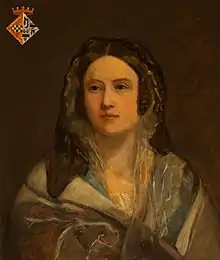Sophia Crichton-Stuart, Marchioness of Bute
Sophia Crichton-Stuart, Marchioness of Bute (1 February 1809 – 28 December 1859), formerly Lady Sophia Frederica Christina Rawdon-Hastings, was a Scottish noblewoman. She was the second wife of John Crichton-Stuart, 2nd Marquess of Bute, and the mother of the 3rd Marquess. Cardiff's Sophia Gardens are named after her.[1]
The Marchioness of Bute | |
|---|---|
 | |
| Born | Lady Sophia Frederica Christina Rawdon-Hastings 1 February 1809 |
| Died | 28 December 1859 (aged 50) Edinburgh, Scotland |
| Burial place | Rothesay, Isle of Bute |
| Spouse | |
| Children | John Crichton-Stuart, 3rd Marquess of Bute |
| Parent(s) | Francis Rawdon-Hastings, Earl of Moira Flora Campbell, 6th Countess of Loudoun |
Family background

Sophia was the daughter of Flora Campbell, 6th Countess of Loudoun, and her husband Francis Rawdon-Hastings, Earl of Moira. Her father became Governor-General of India and Governor of Malta and was raised to the rank of Marquess of Hastings in 1816. He died in 1826. Sophia's elder sister was Lady Flora Hastings, a lady-in-waiting at the court of Queen Victoria of the United Kingdom. Lady Flora died in 1839 of a tumour, in circumstances that gave rise to a scandal in the court, and was nursed by Sophia. Their mother died in the following year.[2] Lady Flora wrote poetry, and after her death Sophia edited an edition of her poems.[3]
Sophia married the Marquess of Bute, who was fifteen years older than her, on 10 April 1845 at Loudoun Castle, Ayrshire,[4] his first wife, Lady Maria North, having died in 1841. He had no children from his first marriage, and died aged 54 in Cardiff,[5] only three years after his second marriage, leaving a six-month-old son who succeeded to the marquessate.
Sophia's first pregnancy had ended in a stillbirth.[2] Her son John, the 3rd Marquess, was born on 12 September 1847 at Mount Stuart House on the Isle of Bute, Scotland.[6][7]
Philanthropy
The marchioness's Scottish roots did not prevent her taking an interest in the city of Cardiff, where her husband had had vast commercial and industrial interests. Sophia was an early supporter of the Welsh language; seeking to learn it herself, giving money for the establishment of the Welsh college at Llandovery, and providing financial assistance for the Eisteddfod.[8] She was also responsible for donating the land and financing the construction of All Saints Church for Welsh-speaking Anglicans, in Tyndall Street, Cardiff.[9] She took a particular interest in the appointment of clergy to livings in South Wales. In 1848 she wrote to her husband's agent, expressing her dismay at the action of the then Lord Chancellor, the Earl of Cottenham, who had the patronage of the parish of Llanilid and had presented the parish, "where hardly anyone speaks English, (to) a man without Welsh".[8]
In 1858, it was Sophia who granted the people of Cardiff the use of the Bute estates between Cathedral Road and the River Taff for use as the town's first public park.[1] The 18-acre park, named Sophia Gardens, was financed by the Marchioness and included a lodge, flower beds, landscaping and an ornamental pond, supervised by her head gardener and ready to be opened by the summer.[10]
Death
The marchioness died, aged fifty, in Edinburgh, with her twelve-year-old son at her bedside.[2] In her will, she left provision for almshouses to be built near Edinburgh, which she specified were to be named the "Flora Almshouses" after her mother and sister.[11][12] The young marquess arranged for a cast to be taken of his mother's face. A post-mortem confirmed the cause of death as Bright's disease.[2]
The marchioness was buried in the family vault at Rothesay on the Isle of Bute. In his eulogy, the officiating minister described her as "one firm, yet gentle, loving and wise".[2]
References
- Dic Mortimer (15 October 2014). Cardiff The Biography. Amberley Publishing Limited. p. 173. ISBN 978-1-4456-4251-2.
- Rosemary Hannah (30 July 2012). The Grand Designer: Third Marquess of Bute. Birlinn. pp. 1505–1525. ISBN 978-0-85790-227-6.
- Hastings, Flora (1841). Hastings, Sophia F. C. (ed.). Poems by the Lady Flora Hastings. Edinburgh: William Blackwood and Sons. OCLC 1049072964.
- Mosley, Charles, editor. Burke's Peerage, Baronetage & Knightage, 107th edition, 3 volumes. Wilmington, Delaware, U.S.A.: Burke's Peerage (Genealogical Books) Ltd, 2003. volume 1, page 610.
- John Venn (15 September 2011). Alumni Cantabrigienses: A Biographical List of All Known Students, Graduates and Holders of Office at the University of Cambridge, from the Earliest Times to 1900. Cambridge University Press. p. 73. ISBN 978-1-108-03616-0.
- Thomas Nicholas (1872). Annals and Antiquities of the Counties and County Families of Wales: Containing a Record of All Ranks of the Gentry ... with Many Ancient Pedigrees and Memorials of Old and Extinct Families. Longmans, Green, Reader. p. 619.
- Reyonds, K. D. "Stuart, John Patrick Crichton-, third marquess of Bute". Oxford Dictionary of National Biography (online ed.). Oxford University Press. doi:10.1093/ref:odnb/26722. (Subscription or UK public library membership required.)
- John Davies (1981). Cardiff and the Marquesses of Bute. University of Wales Press. pp. 101–131. ISBN 0-7083-0761-2. OCLC 731224268.
- "History". Church in Wales. Retrieved 16 June 2019.
- "Glamorganshire". The Welshman. 12 March 1858. p. 4 – via Welsh Newspapers online.
- The Scottish Law Reporter: Continuing Reports ... of Cases Decided in the Court of Session, Court of Justiciary, Court of Teinds, and House of Lords. W.&R.A. Veitch. 1881. p. 192.
- "Clayton and Gibson papers". Durham University. Retrieved 18 June 2019. Summary of the will of Sophia Frederica Christina, Marchioness of Bute.